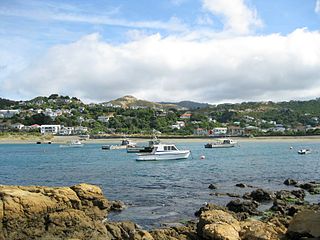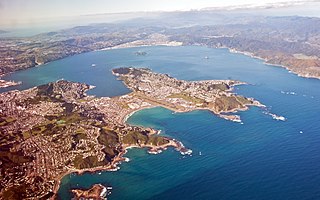 W
WCook Strait is a strait that separates the North and South Islands of New Zealand. It connects the Tasman Sea on the northwest with the South Pacific Ocean on the southeast, and runs next to the capital city, Wellington. It is 22 kilometres (14 mi) wide at its narrowest point, and is considered one of the most dangerous and unpredictable waters in the world.
 W
WBaring Head Lighthouse is a concrete lighthouse at Baring Head in the Wellington Region of the North Island of New Zealand, with an LED beacon powered by mains electricity. It is owned and operated by Maritime New Zealand, and can be accessed via walking tracks in the southern area of the East Harbour Regional Park, south of Wainuiomata.
 W
WBreaker Bay is a suburb on the south east coast of Wellington City in New Zealand, on the Miramar Peninsula. The suburb contains a 600 m wide bay of the same name, and is part of the western shore of the Wellington Harbour entrance. The Eastern Walkway runs along the top of the Bay and has views of the area.
 W
WThe Brothers is a group of small islands in Cook Strait, New Zealand, off the east coast of Arapaoa Island.
 W
WCape Campbell, Te Karaka in the Māori language, is in Marlborough, New Zealand, on the northeastern coast of the South Island. It lies at the southern end of Clifford Bay, 15 kilometres (9 mi) northeast of Ward, and 42 kilometres (26 mi) southeast of Blenheim. Cape Campbell lies close to the salt works at Lake Grassmere.
 W
WCape Palliser is a promontory on the southern coast of New Zealand's North Island and is the southernmost point of the North Island; it is in fact considerably farther south than Nelson or Blenheim in the South Island.
 W
WCape Terawhiti is the southwesternmost point of the North Island of New Zealand.
 W
WClifford Bay is a bay in the northeast of the South Island of New Zealand, in the Marlborough Region. It lies between Cloudy Bay to the northwest, and Cape Campbell. The bay's most notable feature is the solar salt extraction works at Lake Grassmere, close to the southern end of the bay.
 W
WFitzroy Bay is a bay close to the entrance of Wellington Harbour in New Zealand. It lies to the southeast of the entrance to the harbour, between Pencarrow Head and Baring Head.
 W
WHoughton Bay and Valley is one of the southern suburbs of Wellington, New Zealand. It is located between Island Bay and Lyall Bay, on the rocky shores of the Cook Strait. It has two beaches, Houghton Bay and Princess Bay, used by surfers, swimmers and divers.
 W
WIsland Bay is a coastal suburb of Wellington, the capital of New Zealand, situated 5 km south of the city centre.
 W
WThe Marlborough Sounds are an extensive network of sea-drowned valleys at the northern end of the South Island of New Zealand. The Marlborough Sounds were created by a combination of land subsidence and rising sea levels. According to Māori mythology, the sounds are the prows of the sunken wakas of Aoraki.
 W
WPalliser Bay is at the southern end of the North Island of New Zealand, to the southeast of Wellington. It runs for 40 kilometres along the Cook Strait coast from Turakirae Head at the southern end of the Rimutaka Ranges to Cape Palliser, the North Island's southernmost point.
 W
WPelorus Jack was a Risso's dolphin that was famous for meeting and escorting ships through a stretch of water in Cook Strait, New Zealand, for 24 years between 1888 and 1912. Pelorus Jack was usually spotted in Admiralty Bay between Cape Francis and Collinet Point, near French Pass, a notoriously dangerous channel used by ships travelling between Wellington and Nelson.
 W
WPencarrow Head Lighthouse is a decommissioned lighthouse at Pencarrow Head in the Wellington Region of the North Island of New Zealand.
 W
WRongotai is a suburb of Wellington, New Zealand, located southeast of the city centre. It is on the Rongotai isthmus, between the Miramar Peninsula and the suburbs of Kilbirnie and Lyall Bay. It is known mostly for being the location of the Wellington International Airport. It is roughly in the centre of the Rongotai electorate, which is much bigger than the suburb.
 W
WStraits Air Freight Express (SAFE) was a cargo airline, established in 1950, named for its Cook Strait focus and connecting the North Island and South Islands of New Zealand's railway systems from the 1950s to the 1970s. The company was renamed Safe Air Limited in 1966 and diversified into aviation maintenance. In 1972 it was bought by the National Airways Corporation, which then merged with Air New Zealand. Safe Air continued to be operated as an independent entity by both owners. It ceased flying in 1990, but has continued to expand as a maintenance facility and now employs approximately 350 staff. In 2015 it was bought by the Australian arm of Airbus.
 W
WTurakirae Head is a promontory on the southern coast of New Zealand's North Island. It is located at the western end of Palliser Bay, 20 kilometres southeast of Wellington, at the southern end of the Remutaka Range. The head is an excellent example of tectonic uplift within the Wellington region. There are a series of raised terraces which show where the beach has been prior to a seismic event. Turakirae Head is also home to a seal colony.
 W
WWellington Harbour is the large natural harbour on the southern tip of New Zealand's North Island. New Zealand's capital city, Wellington, is located on its western side. The harbour, the sea area bounded by a line between Pencarrow Head to Petone foreshore, was officially named Port Nicholson, until it assumed its current name in 1984.